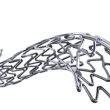Patients with chronic kidney disease (CKD) undergoing coronary angiography are at increased risk of developing contrast-associated acute kidney injury (CA-AKI), which is associated with increased mortality. According to current guidelines, the standard treatment for preventing CA-AKI in patients with moderate to severe CKD is long-duration peri-procedural intravenous hydration with saline solution. This standard hydration is...
What Is the Prognosis of an Acute Myocardial Infarction in the Presence of Moderate Aortic Stenosis?
Aortic stenosis (AS) is a common condition that shares risk factors with coronary artery disease. Many patients can suffer from both diseases simultaneously, something that increases the risk of acute myocardial infarction in the presence of aortic stenosis. AS can cause ischemia even in the absence of coronary artery disease, due to ventricular hypertrophy, increased...
Relationship between Distal Vessel Quality and Outcomes in the Treatment of Chronic Total Occlusions
Percutaneous treatment of chronic total occlusions has increase, and has become a a more habitual therapeutic challenge. However, there is limited information on distal vessel quality and its association with outcomes and techniques. This variable appears to be excluded form CTO scores, except for the RECHARGE (REgistry of CrossBoss and Hybrid procedures in FrAnce, the...
Aortic Stenosis and Cardiogenic Shock: Is TAVR an Option?
Cardiogenic shock (CS) in a setting of aortic stenosis is associated with high mortality rates. In consequence, surgery is generally not a possibility for this patient group, and they usually undergo aortic valvuloplasty, resulting in a mortality rate of 33%-50% at 30 days, 70% at one year, and 90% at two years. While transcatheter aortic...
A New Alternative for the Treatment of Heart Failure: Left Atrial to Coronary Sinus Shunt with the APTURE Device
ALT FLOW device for left atrial to coronary sinus shunting in symptomatic heart failure patients. In the treatment of heart failure (HF), significant improvement in patient quality of life and prognosis has been achieved through appropriate medical treatment and, in some cases, the use of devices. However, in certain cases, satisfactory clinical improvement cannot be...
We Should Revascularize Patients with Stable Coronary Syndromes and Ischemia Assessed by iFR
Chronic stable angina has shown a good response to medical treatment, and the Ischemia study has recently demonstrated the safety of such treatment in stable chronic angina with moderate to severe ischemia. However, this study excluded left main coronary artery (LMCA) lesions. The FAME Study has shown the safety and efficacy of fractional flow reserve...
Calcified Nodules and the Importance of OCT Categorization prior PCI
TLR associated factors in patients with calcified nodules. Patients with complex cardiomyopathies undergoing percutaneous coronary intervention are increasingly common, as is the case for calcified lesions and calcified nodules (CN). Procedure complexity not only involves planning, but also establishing patient prognosis, taking into consideration the fact that most target vessel events occur at long term...
TAVI in Moderate Aortic Stenosis with Low Ejection Fraction
The presence of aortic stenosis, heart failure, and decreased ventricular function is associated with poor prognosis and high mortality. For this reason, both European and American guidelines classify severe stenosis as a Class I indication. There are two retrospective analyses that demonstrate the benefits of transcatheter aortic valve implantation (TAVI) via transfemoral access. The TAVR...
5 Year Evolution of PCI vs CABG in Large Randomized Studies on Acute and Chronic Coronary Syndrome
Left main lesions in acute coronary syndrome (ACS) represent a major risk and, at present, the best revascularization strategy is a matter of debate. Though many studies and registries have excluded this group of patients, there is data on the pros and cons of both percutaneous coronary intervention (PCI) and cardiac artery bypass graft (CABG). ...
Diffuse Coronary Artery Disease: One-Year 48mm XIENCE Skypoint Outcomes
Long 48mm Stent XIENCE Skypoint in the treatment of diffuse CAD Long coronary artery lesions often involve complex decision making since they can be treated either with a long stent or with shorter overlapping stents. Both in registries and meta-analysis, the overlapping technique has been associated to increased target vessel revascularization and increased radioscopy time,...









